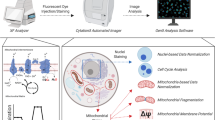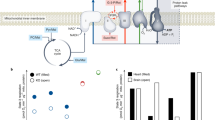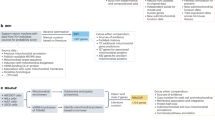Abstract
Mitochondrial dysfunction has been associated with a variety of currently marketed therapeutics and has also been implicated in many disease states. Alterations in the rate of oxygen consumption are an informative indicator of mitochondrial dysfunction, but the use of such assays has been limited by the constraints of traditional measurement approaches. Here, we present a high-throughput, fluorescence-based methodology for the analysis of mitochondrial oxygen consumption using a phosphorescent oxygen-sensitive probe, standard microtitre plates and plate reader detection. The protocol describes the isolation of mitochondria from animal tissue, initial establishment and optimization of the oxygen consumption assay, subsequent screening of compounds for mitochondrial toxicity (uncoupling and inhibition), data analysis and generation of dose-response curves. It allows dozens of compounds (or hundreds of assay points) to be analyzed in a single day, and can be further up-scaled, automated and adapted for other enzyme- and cell-based screening applications.
This is a preview of subscription content, access via your institution
Access options
Subscribe to this journal
Receive 12 print issues and online access
$259.00 per year
only $21.58 per issue
Buy this article
- Purchase on Springer Link
- Instant access to full article PDF
Prices may be subject to local taxes which are calculated during checkout



Similar content being viewed by others
References
Waterhouse, N.J., Ricci, J.-E. & Green, D.R. And all of a sudden it's over: mitochondrial outer-membrane permeabilization in apoptosis. Biochimie 84, 113–121 (2002).
Amacher, D.E. Drug-associated mitochondrial toxicity and its detection. Curr. Med. Chem. 12, 1829–1839 (2005).
Ballinger, S.W. Mitochondrial dysfunction in cardiovascular disease. Free Radic. Biol. Med. 38, 1278–1295 (2005).
Moyle, G. Mechanisms of HIV and nucleoside reverse transcriptase inhibitor injury to mitochondria. Antivir. Ther. 10, M47–M52 (2005).
Sullivan, P.G. & Brown, M.R. Mitochondrial aging and dysfunction in Alzheimer's disease. Prog. Neuropsychopharmacol. Biol. Psychiatry 29, 407–410 (2005).
Mattson, M.P. & Kroemer, G. Mitochondria in cell death: novel targets for neuroprotection and cardioprotection. Trends Mol. Med. 9, 196–205 (2003).
Lewis, W., Day, B.J. & Copeland, W.C. Mitochondrial toxicity of NRTI antiviral drugs: an integrated cellular perspective. Nat. Rev. Drug Discov. 2, 812–822 (2003).
Brunmair, B. et al. Fenofibrate impairs rat mitochondrial function by inhibition of respiratory complex I. J. Pharmacol. Exp. Ther. 311, 109–114 (2004).
Wallace, K.B. Doxorubicin-induced cardiac mitochondrionopathy. Pharmacol. Toxicol. 93, 105–115 (2003).
Sirvent, P. et al. Simvastatin induces impairment in skeletal muscle while heart is protected. Biochem. Biophys. Res. Commun. 338, 1426–1434 (2005).
Kangas, L., Gronroos, M. & Nieminen, A.L. Bioluminescence of cellular ATP: a new method for evaluating cytotoxic agents in vitro . Med. Biol. 62, 338–343 (1984).
Simon, H.U., Haj-Yehia, A. & Levi-Schaffer, F. Role of reactive oxygen species (ROS) in apoptosis induction. Apoptosis 5, 415–418 (2000).
Li, N. et al. Mitochondrial complex I inhibitor rotenone induces apoptosis through enhancing mitochondrial reactive oxygen species production. J. Biol. Chem. 278, 8516–8525 (2003).
Scaduto, R.C. Jr. & Grotyohann, L.W. Measurement of mitochondrial membrane potential using fluorescent rhodamine derivatives. Biophys. J. 76, 469–477 (1999).
Reers, M. et al. Mitochondrial membrane potential monitored by JC-1 dye. Methods Enzymol. 260, 406–417 (1995).
Hynes, J. et al. Investigation of drug-induced mitochondrial toxicity using fluorescence-based oxygen-sensitive probes. Toxicol. Sci. 92, 186–200 (2006).
Crompton, M., Virji, S., Doyle, V., Johnson, N. & Ward, J.M. The mitochondrial permeability transition pore. Biochem. Soc. Symp. 66, 167–179 (1999).
Vander Heiden, M.G. et al. Outer mitochondrial membrane permeability can regulate coupled respiration and cell survival. Proc. Natl. Acad. Sci. USA 97, 4666–4671 (2000).
Clark, L.C. Electrochemical device for chemical analysis. US patent 2913386 (1959).
Lakowicz, J.R. Principles of Fluorescence Spectroscopy (Plenum Press, New York, 1999).
Papkovsky, D.B. Methods in optical oxygen sensing: protocols and critical analyses. Methods Enzymol. 381, 715–735 (2004).
Demas, J.N., DeGraff, B.A. & Coleman, P.B. Oxygen sensors based on luminescence quenching. Anal. Chem. 71, 793A–800A (1999).
O'Riordan, T.C., Buckley, D., Ogurtsov, V., O'Connor, R. & Papkovsky, D.B. A cell viability assay based on monitoring respiration by optical oxygen sensing. Anal. Biochem. 278, 221–227 (2000).
Wodnicka, M. et al. Novel fluorescent technology platform for high throughput cytotoxicity and proliferation assays. J. Biomol. Screen. 5, 141–152 (2000).
John, G.T., Klimant, I., Wittmann, C. & Heinzle, E. Integrated optical sensing of dissolved oxygen in microtiter plates: a novel tool for microbial cultivation. Biotechnol. Bioeng. 81, 829–836 (2003).
Deshpande, R.R. & Heinzle, E. On-line oxygen uptake rate and culture viability measurement of animal cell culture using microplates with integrated oxygen sensors. Biotechnol. Lett. 26, 763–767 (2004).
Deshpande, R.R. et al. Microplates with integrated oxygen sensors for kinetic cell respiration measurement and cytotoxicity testing in primary and secondary cell lines. Assay Drug Dev. Technol. 3, 299–307 (2005).
Hynes, J., Floyd, S., Soini, A.E., O'Connor, R. & Papkovsky, D.B. Fluorescence-based cell viability screening assays using water-soluble oxygen probes. J. Biomol. Screen. 8, 264–272 (2003).
O'Donovan, C., Hynes, J., Yashunski, D. & Papkovsky, D.B. Phosphorescent oxygen-sensitive materials for biological applications. J. Mater. Chem. 15, 2946–2951 (2005).
Alderman, J. et al. A low-volume platform for cell-respirometric screening based on quenched-luminescence oxygen sensing. Biosens. Bioelectron. 19, 1529–1535 (2004).
O'Mahony, F.C. et al. Optical oxygen microrespirometry as a platform for environmental toxicology and animal model studies. Environ. Sci. Technol. 39, 5010–5014 (2005).
Papkovsky, D.B., Hynes, J. & Will, Y. Respirometric screening technology for ADME-Tox studies. Expert Opin. Drug Metab. Toxicol. 2, 313–323 (2006).
Arain, S. et al. Gas sensing in microplates with optodes: influence of oxygen exchange between sample, air, and plate material. Biotechnol. Bioeng. 90, 271–280 (2005).
Hynes, J., O'Riordan, T.C., Curtin, J., Cotter, T.G. & Papkovsky, D.B. Fluorescence based oxygen uptake analysis in the study of metabolic responses to apoptosis induction. J. Immunol. Methods 306, 193–201 (2005).
O'Mahony, F.C. & Papkovsky, D.B. Rapid high throughput assessment of aerobic bacteria in complex samples by fluorescence-based oxygen respirometry. Appl. Environ. Microbiol. 72, 1279–1287 (2006).
Hynes, J., Hill, R. & Papkovsky, D.B. The use of a fluorescence-based oxygen uptake assay in the analysis of cytotoxicity. Toxicol. In Vitro 20, 785–792 (2006).
Guide for the Care and Use of Laboratory Animals. NIH Publication No. 85-23 (NIH, Bethesda, MD, USA, revised 1985).
Lapidus, R.G. & Sokolove, P.M. Spermine inhibition of the permeability transition of isolated rat liver mitochondria: an investigation of mechanism. Arch. Biochem. Biophys. 306, 246–253 (1993).
Messer, J.I., Jackman, M.R. & Willis, W.T. Pyruvate and citric acid cycle carbon requirements in isolated skeletal muscle mitochondria. Am. J. Physiol. Cell Physiol. 286, C565–C572 (2004).
Stern, O. & Volmer, M. Uber die ablingungszeit der fluoreszenz. Physik. Zeitschr. 20, 183–188 (1919).
Acknowledgements
Parts of this work were supported by the Marine Institute and Marine RTDI Measure, Productive Sector Operational Programme, National Development Plan 2000–2006, Grant-aid agreement No AT-04-01-01, which is gratefully acknowledged.
Author information
Authors and Affiliations
Corresponding author
Ethics declarations
Competing interests
D. Papkovsky is one of the stakeholders of Luxcol Biosciences. All the other authors have no competing financial interests.
Rights and permissions
About this article
Cite this article
Will, Y., Hynes, J., Ogurtsov, V. et al. Analysis of mitochondrial function using phosphorescent oxygen-sensitive probes. Nat Protoc 1, 2563–2572 (2006). https://doi.org/10.1038/nprot.2006.351
Published:
Issue Date:
DOI: https://doi.org/10.1038/nprot.2006.351
This article is cited by
-
Oxygen consumption rate to evaluate mitochondrial dysfunction and toxicity in cardiomyocytes
Toxicological Research (2023)
-
A practical guide for the analysis, standardization and interpretation of oxygen consumption measurements
Nature Metabolism (2022)
-
Magnetically Reusable and Well-dispersed Nanoparticles for Oxygen Detection in Water
Journal of Fluorescence (2022)
-
Automated segmentation and tracking of mitochondria in live-cell time-lapse images
Nature Methods (2021)
-
Perfluorocarbon regulates the intratumoural environment to enhance hypoxia-based agent efficacy
Nature Communications (2019)
Comments
By submitting a comment you agree to abide by our Terms and Community Guidelines. If you find something abusive or that does not comply with our terms or guidelines please flag it as inappropriate.



